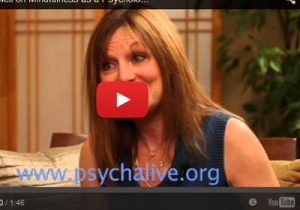VIDEO: Formal Sitting Meditation Practice
In her interview with PsychAlive Senior Editor Lisa Firestone, Dr. Donna Rockwell describes, in detail, formal sitting meditation practice. Watch or read the interview below.
First the notion is that it really matters sort of how we sit and what our posture is and as we sit in the chair is how we are in life. So we want to have our backs really straight, our chest open, our shoulders back and they say that our spine is like a stack of golden coins and we sit with this stack of golden coins and that everybody has what’s also called precious human birth.
That it is an absolute gift to get born and to be able to be alive, even though we will eventually get sick and die. But at least we get the chance to be alive. So this notion of precious human birth, and the idea that in each and every person there’s basic goodness.
And all the stories we tell ourselves all day long: I’m not good at this, I’m bad at that, I’m not this – it’s just not true, you know. But underneath all of that discursive thinking is this basic goodness that every person living on the earth has. So there’s this sense of dignity, everyone’s a king or queen on their own chair or their own cushion, so a sense of really self-regard and self-respect.
So, head is straight, hands are flat on the thighs, eyes are open in this meditation, downcast, on the floor, a couple of feet in front of you because this isn’t so much a guided meditation where we’re learning how to relax and go to the beach.
This is a meditation of learning how to befriend ourselves and stay present to what’s going on right now. And to be present in the here and now with ourselves. We’re not going anywhere. So that’s why the eyes are open. If you’re more comfortable closing them, of course you can.
So as we sit here like a mountain, the mountain just sits and the weather passes over it. And the mountain doesn’t really care. So in that same sort of equanimity, we sit. And as we sit, the first thing we do is we become aware of our breath, as it goes out and dissolves. Then there’s a tiny gap, then the in breath naturally occurs, tiny gap at the end of the in breath and then once again, that long slow, dissolving, out breath.
That out breath is the breath that trains the mind to let go. It creates a whole new network of dendrites and neurons. We have a greater physiology to work with. So we’re training the mind to let go with the out breath. It’s the same breath that understands impermanence. And when we can connect to the out breath, we no longer have to cling or grasp at or become overly attached to a particular outcome.
We’re learning how to let go of all of that with that out breath. They also say that all the wisdom in the world is located in the gaps between thoughts, in the space between breaths. So we need to focus on the whole gestalt of the experience, not just on the content.
So about 40 percent of our attention stays on the breath going out and dissolving, tiny gap, in breath naturally occurring, tiny gap, long slow dissolving out breath. And then 60 percent of our attention is on incoming stimuli through our 5 senses. So, we see the light on the ceiling, we see the pattern on the carpet. We feel the skin of our palm against our pant leg or the heel of our foot inside of our shoe. We hear traffic outside. Maybe we smell dinner cooking downstairs.
So we’re really heightening our awareness by being aware of all our senses and everything we’re experiencing through them. So meditation practice is being with the breath as it goes out and dissolves, tiny gap, in breath, tiny gap, awareness of the five senses and stimuli coming through them.
And then what you do is you notice when your mind is gone from this particular practice and you’re thinking about what Joe said to you yesterday that hurt your feelings or the project you have due at work next week that’s giving you so much anxiety. And what you very gently and simply do, they say like a feather to a balloon, with a very light, tender, gentle touch, you simply label that thinking. You say in your mind, thinking. And you return awareness from that discursive thought back to the long slow dissolving out breath.
We find ourselves gone, lost in thought because the mind, they say, is like a busy monkey, jumping all around. Not your mind or my mind, but everyone’s mind. And so we’re really training the mind to return. That’s what formal practice is. Training the mind to return from discursive thought to the present here and now moment.
So, we can do this at any time. You can do it for five minutes in the morning before work, in the middle of the day, the end of the day. Just spend a few minutes doing this, following breath out, the letting go breath, tiny gap, in breath naturally occurring. We don’t focus on that too much because that’s the breath associated with hyperventilation. We will breath in, not to worry. Tiny gap and then all of our attention on that — long slow dissolving out breath. Awareness of stimuli through our five senses.
And then, as we try to navigate that exercise, we’ll find that low and behold we’re gone. Lost in thought. It could be 2 seconds, 2 minutes, an hour, however long it is, you simply and gently just say [to yourself], “Thinking.” And return awareness to the long slow dissolving out breath.
So that’s pretty much formal meditation instruction and if you sat and did it for a few minutes, you would see that you feel more enlivened. And, you know, the mind is always going to jump around so the beauty and the challenge, the gift is really all we need to really learn is how to come back because we can’t stay here. It comes in glimpses.
The notion of like feeling the palm of your hand against you pant leg, there’s so much of things that happen all day long that we miss. And so this really helps us to stay more present so we don’t miss that beautiful aura or the look on a child’s face that can be so touching and moving to us and healing in our relationship with our child. So this is really formal practice and you just, you know, you keep coming back to the out breath and it looks like we’re sitting here doing nothing but we’re sitting here doing so, so much.
Tags: cultivating mindfulness, meditation, meditation practices, mindfulness









Leave a Reply
You must be logged in to post a comment.